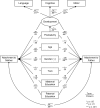Parent-child attachment in children born preterm and at term: A multigroup analysis
- PMID: 30161170
- PMCID: PMC6116993
- DOI: 10.1371/journal.pone.0202972
Parent-child attachment in children born preterm and at term: A multigroup analysis
Abstract
Objective: While ample research exists about mother-child attachment, so far little focus has been on specifics of father-child attachment. Even less research is available on the nature of the father-child relationship for children born preterm. The objective of this study was to determine whether children born preterm (23 to 37 weeks gestation) differ in their attachment to their fathers and mothers from their term peers (> 37 weeks gestation), and whether specific child characteristics, such as gender, twin status, and developmental status, have an influence on the parent-child relationship.
Methods: The sample consisted of 290 children (n = 140 girls, 48.28%), 190 born before term (including 45 twin pairs) between 12 and 36 months of age (M = 19.5, SD = 5.7) and 100 term children of the same age (M = 18.8, SD = 6.1) with their 245 fathers and mothers. Attachment of the children with their mothers and fathers was assessed using the Attachment Q-sort during two home visits. Children's developmental status was measured with the Bayley Scales of Infant and Toddler Development.
Results: Within a multigroup analysis of parents with children born preterm and at term more secure attachment was found for both parents in the term sample than in the preterm group. Correlates of attachment specific to fathers of children born preterm accumulated to an explained variance of R2 = .82. For those fathers, less education as well as lower development scores and male gender of the child were associated with lower attachment scores. In the three other parent-child constellations the explained variance did not exceed 20%. Child development proved to be a significant predictor for father-child attachment regardless of the child's birth status. Male gender was associated with lower attachment scores for children born preterm with either parent.
Conclusion: The findings highlight the importance of including fathers in research and clinical practice and informing them about preterm birth, possible problems, and developmental consequences as well. Health professionals should be advised to create interventions focusing on both parents to enhance the quality of attachment in parent-child dyads in children born preterm.
Conflict of interest statement
The authors have declared that no competing interests exist.
Figures
Similar articles
-
Reflective functioning in fathers with young children born preterm and at term.Attach Hum Dev. 2020 Feb;22(1):32-45. doi: 10.1080/14616734.2019.1589059. Epub 2019 Mar 21. Attach Hum Dev. 2020. PMID: 30898032
-
Maternal and paternal infant representations: a comparison between parents of term and preterm infants.Infant Behav Dev. 2014 Aug;37(3):366-79. doi: 10.1016/j.infbeh.2014.05.004. Epub 2014 Jun 2. Infant Behav Dev. 2014. PMID: 24887535
-
Early intervention program reduces stress in parents of preterms during childhood, a randomized controlled trial.Trials. 2014 Oct 4;15:387. doi: 10.1186/1745-6215-15-387. Trials. 2014. PMID: 25282345 Free PMC article. Clinical Trial.
-
The Importance of Follow-Up Visits for Children at Risk of Developmental Delay-A Review.Diagnostics (Basel). 2024 Aug 13;14(16):1764. doi: 10.3390/diagnostics14161764. Diagnostics (Basel). 2024. PMID: 39202251 Free PMC article. Review.
-
A systematic review on attachment and down syndrome.J Intellect Dev Disabil. 2023 Dec;48(4):409-420. doi: 10.3109/13668250.2023.2208744. Epub 2023 May 28. J Intellect Dev Disabil. 2023. PMID: 39815888
Cited by
-
The Association between Prematurity, Antibiotic Consumption, and Mother-Infant Attachment in the First Year of Life.Antibiotics (Basel). 2023 Feb 2;12(2):309. doi: 10.3390/antibiotics12020309. Antibiotics (Basel). 2023. PMID: 36830220 Free PMC article.
-
Neurodevelopmental, Mental Health, and Parenting Issues in Preterm Infants.Children (Basel). 2023 Sep 18;10(9):1565. doi: 10.3390/children10091565. Children (Basel). 2023. PMID: 37761526 Free PMC article.
-
Musical and vocal interventions to improve neurodevelopmental outcomes for preterm infants.Cochrane Database Syst Rev. 2023 Sep 7;9(9):CD013472. doi: 10.1002/14651858.CD013472.pub2. Cochrane Database Syst Rev. 2023. PMID: 37675934 Free PMC article.
-
Mental Health Outcomes of a National Cohort of Adults Born with Very Low Birthweight.J Clin Med. 2024 Dec 13;13(24):7591. doi: 10.3390/jcm13247591. J Clin Med. 2024. PMID: 39768513 Free PMC article.
-
A guided participation nursing intervention to theraupeutic positioning and care (GP_Posit) for mothers of preterm infants: protocol of a pilot randomized controlled trial.Pilot Feasibility Stud. 2020 May 26;6:77. doi: 10.1186/s40814-020-00601-5. eCollection 2020. Pilot Feasibility Stud. 2020. PMID: 32509322 Free PMC article.
References
-
- Cassidy J, Shaver PR. Handbook of attachment: Theory, research, and clinical applications 3rd ed. New York, NY: The Guilford Press; 2016.
-
- Lamb ME. How do fathers influence children`s development? Let me count the ways In: Lamb ME, editor. The role of the father in child development. 5th ed. Hoboken, NJ: Wiley; 2010. p. 1–26.
Publication types
MeSH terms
LinkOut - more resources
Full Text Sources
Other Literature Sources



